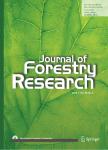Sub-stand diameter distribution types vary along an old-growth Douglas-fir chronosequence into the horizontal diversification development stage
作者机构:Department of Ecosystem Science and ManagementThe Pennsylvania State UniversityUniversity ParkPA 16802USA
出 版 物:《Journal of Forestry Research》 (林业研究(英文版))
年 卷 期:2023年第34卷第2期
页 面:415-424页
核心收录:
学科分类:0830[工学-环境科学与工程(可授工学、理学、农学学位)] 0907[农学-林学] 0829[工学-林业工程] 09[农学] 0903[农学-农业资源与环境] 0901[农学-作物学]
基 金:funded by USDA National Institute of Food and Agriculture Hatch Appropriations[#PEN04639 Accession#1015105 EZ]
主 题:Diameter distribution type Floating neighborhood Restoration silviculture Small-scale Structural complexity
摘 要:Managing mature Douglas-fir[Pseudotsuga menziesii(Mirb.)Franco]stands to emulate the structural complexity of natural old-growth forest requires identifying structural targets at the sub-stand level at which neighborhood dynamics and patchy disturbance shape *** therefore sought to describe the archetypal shapes of predominant sub-stand diameter distribution types(DDTs)observed in natural tree neighborhoods in stands comprising a chronosequence(ca.120-450+yrs)encompassing mature,vertical diversification,and horizontal diversification development *** ten 1.0 ha stands are located in the southcentral Oregon Cascades,*** on the known spatial position of each tree,natural tree neighborhoods were identified using the floating neighborhood approach based on spatial tessellation connecting neighboring trees at the first-(mean 61 m2)through fifth-(mean 2058 m2)order *** analysis was then used to objectively identify the most predominant DDTs among the relative tree size distributions observed in the trans-scale neighborhoods within each *** measures regression was used to classify each DDT to one of six observed archetypal shapes:negative exponential,unimodal,rotated sigmoid,bimodal,concave,or *** three of the 81 observed DDTs deviated by50%(maximum 83%).Within each stand,five to ten predominant DDTs were observed,which deviated from the stand average by 30-48%and were characterized by two to five different archetypal ***,in some stands the majority of tree neighborhoods were best characterized by a different shape from that assigned at the stand *** from the stand average increased from the youngest stand in the mature development stage through the middle stands in the vertical diversification stage to the oldest stands in the horizontal diversification *** complexity of DDT shapes tended to increas



